If you’re planning a trip to Sedona, you’ll find a mix of red‑rock adventures and quiet spots for reflection that fit any pace. Hike iconic formations like Cathedral Rock and Devil’s Bridge, wander scenic creeks, catch a sunset from Airport Mesa, or browse galleries and crystal shops in town. There’s more—vortex sites, guided tours, cliffside dining, and hidden trails—that’ll change how you think about the desert.
Hike Cathedral Rock
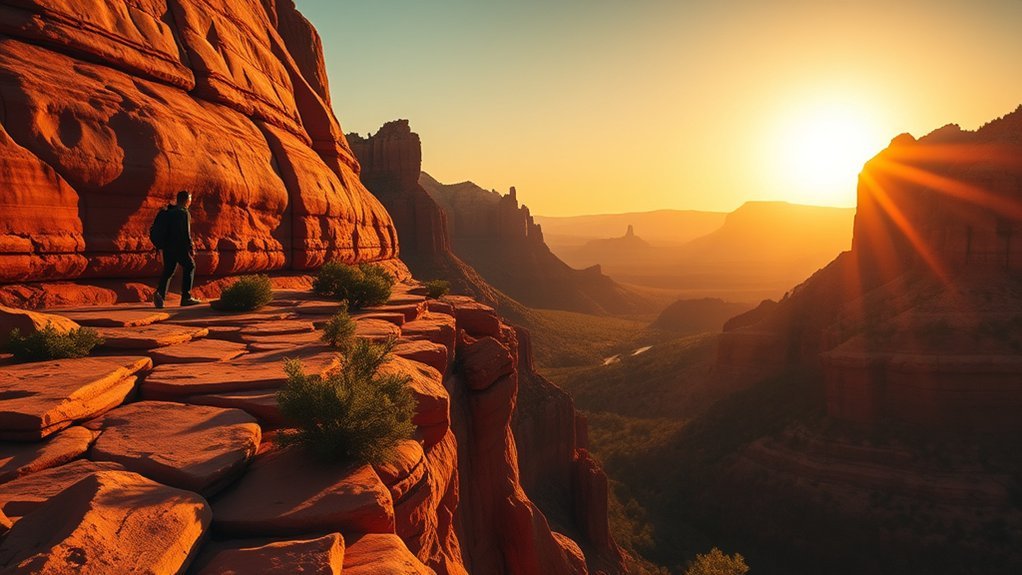
Scramble up the sandstone and you’ll find why Cathedral Rock is Sedona’s most iconic climb: sweeping red spires, narrow sandstone fins, and panoramic views that stretch from Oak Creek Canyon to the Verde Valley. You’ll start on a steep, well-trod trail that quickly turns into a series of rocky steps and slick red slabs; hands and feet work together as you pick footholds and test balance. Wind scours the ledges, leaving warm, granular stone under your palms. Pause at narrow saddles to let the vista unfold — vertiginous drops, layered mesas, and the distant shimmer of desert. Birdsong and the faint scent of juniper keep you rooted in the moment. At the summit, you’ll find natural benches and wide-open sky perfect for a quiet breath or a triumphant photo. Descend carefully; the same features that make Cathedral Rock thrilling demand respect and steady movement.
Explore Bell Rock and Courthouse Butte
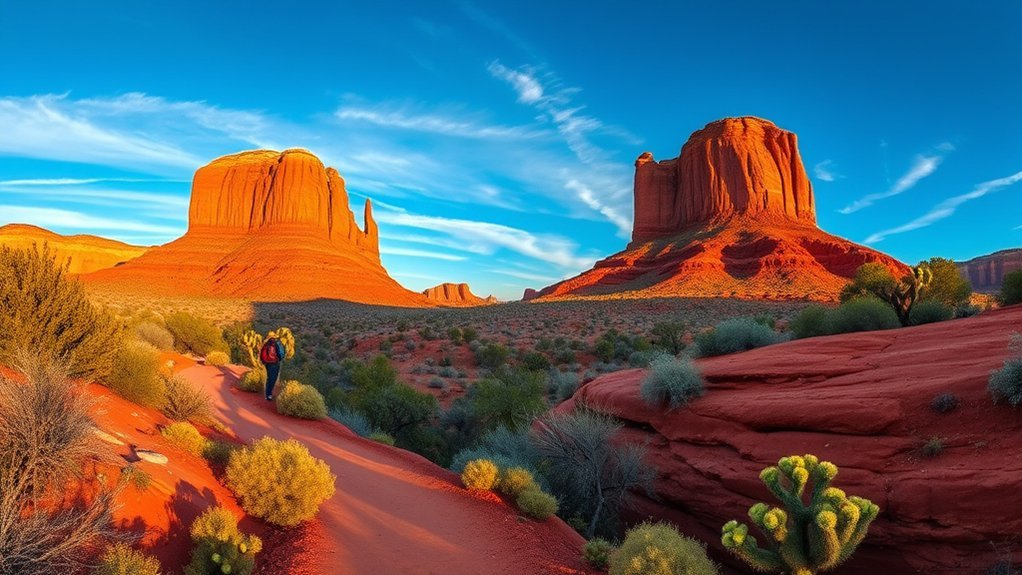
Set just south of Sedona’s main corridor, Bell Rock and neighboring Courthouse Butte rise like rounded guardians of the high desert, their smooth red flanks sliced by faint gullies and sun-warmed ledges you can easily explore. You’ll approach via a network of trails that suit short walks or longer loops; the terrain is forgiving but offers steady climbs that reward you with panoramic views of mesas and distant Verde Valley. Wind and light sculpt every angle, so pause to study layered sandstone, tiny pinyon pines clinging to ledges, and the way shadows deepen crevices. Bring water, sturdy shoes, and a camera — sunrise and late afternoon cast the richest colors. The area feels peaceful even when popular, and you’ll often find quiet side paths to savor solitude or sketch. Use the table below for quick planning.
| Feature | Tip |
|---|---|
| Trails | Choose loop for best views |
| Difficulty | Easy to moderate |
| Best time | Sunrise or late afternoon |
Walk the Devil’s Bridge Trail
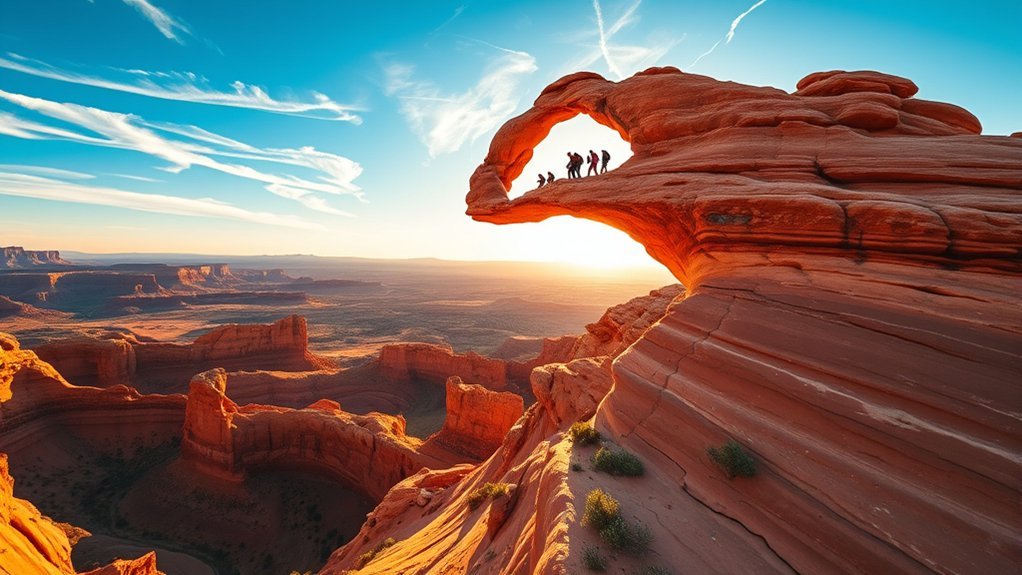
From Bell Rock you can head east and follow the signs to Devil’s Bridge, a short but rewarding hike that ends at one of Sedona’s most photographed natural arches. You’ll climb a mix of sandy switchbacks and red-rock ledges, each turn opening new vistas of ridged spires and scattered junipers. The trail narrows in places, so move deliberately and savor the changing textures underfoot — compacted sand, slickrock, and occasional loose gravel. As the arch appears, the scale hits you: slender sandstone curving above a sudden drop, framed by distant mesas and sky. You can step onto the bridge for photos, but watch your footing and respect others waiting for their turn. Early morning or late afternoon light deepens the reds and casts dramatic shadows, perfect for composition. Bring water, sturdy shoes, and patience for crowds; a quiet moment on the arch, listening to wind through the pines, feels like a small, earned reward.
Stroll the West Fork of Oak Creek
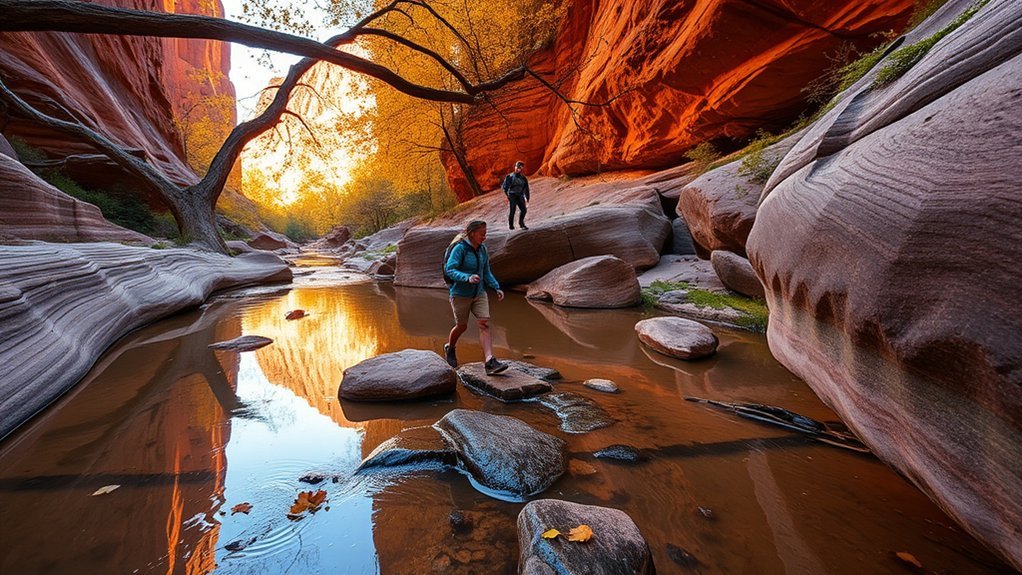
Wander into the cool, shaded gorge of the West Fork of Oak Creek and you’ll trade wide red-rock vistas for a quieter, ribbon-like world of water, willows, and towering canyon walls. You’ll follow a soft, often rocky path that slips alongside the creek, stepping over roots and stones, feeling the spray on your face where the water narrows. Sunlight filters through cottonwoods, dappling the trail and turning the creek into a line of moving light. You’ll hear birds, the clink of pebbles underfoot, and the low hiss of distant traffic fading behind the canyon. Stream crossings invite careful balance or wet shoes; each bend reveals another polished sandstone wall or a small, cool pool perfect for pausing. Bring water, sturdy shoes, and a camera for close-up textures — moss, lichen, and striated rock that reward a slow pace. You’ll leave refreshed, quieter, tuned to the small wonders of the canyon.
Drive the Red Rock Scenic Byway
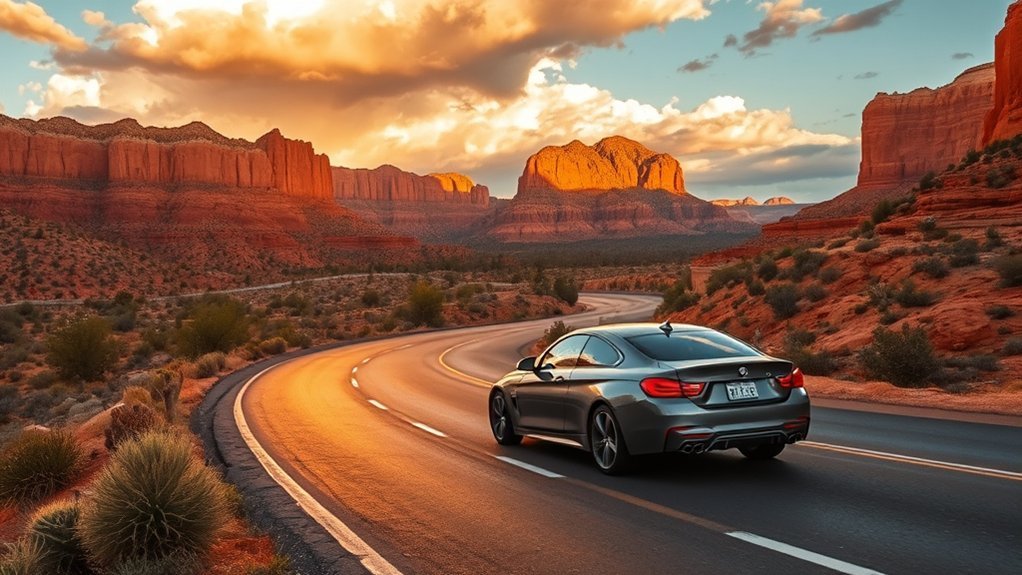
Cruise the Red Rock Scenic Byway and you’ll feel the landscape unfold — red mesas, soaring spires, and sculpted buttes slide past as the road threads through some of Sedona’s most iconic scenery. You’ll steer with intent, windows down, letting warm desert air carry the scent of juniper and pinon. Pullouts appear like framed galleries; each stop offers a new angle — layered cliffs glowing amber, cottonwood pockets by roadside creeks, and distant ridgelines softened by afternoon haze. Photograph sparingly to stay present: the light shifts fast, turning rock from rust to rose. You’ll notice small details too — lichen patterns on boulders, the way shadows carve relief, hawks circling thermal columns. Interpretive signs explain geology and history without slowing your rhythm. Whether you take a short loop or a slow, meandering drive, the byway gives a concentrated immersion in Sedona’s geology and mood, perfect for both quick explorers and those craving deliberate, scenic travel.
Sunset at Airport Mesa
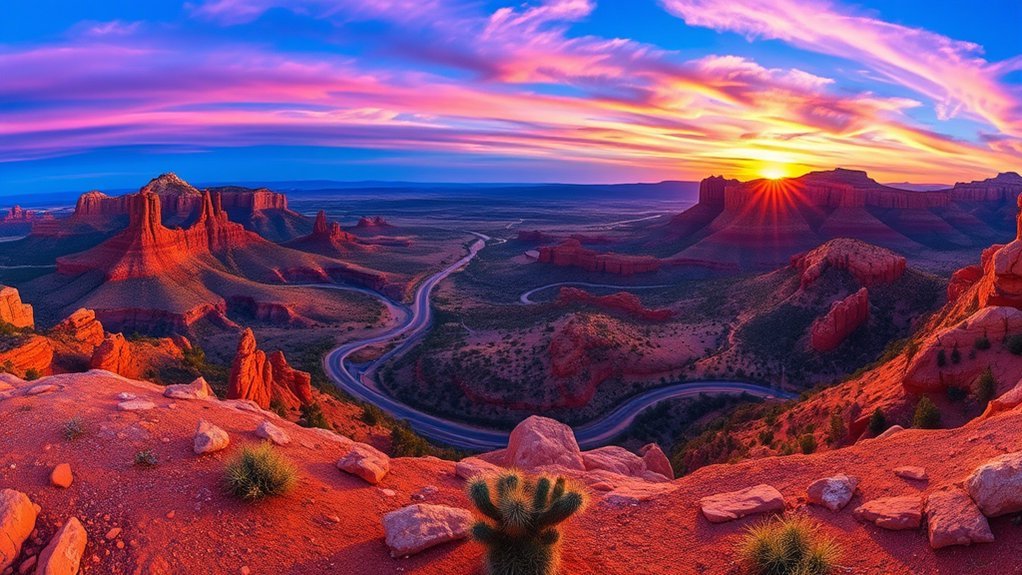
You’ll want to stake out one of Airport Mesa’s rocky overlooks for the best viewpoints, where the red formations glow and shadows stretch across the valley. Go early to grab a spot in the small parking area or park on the access road and walk a few minutes — spots fill fast on weekends. Bring a light jacket and a headlamp for the walk back once the sun dips below the horizon.
Best Viewpoints for Sunset
If you time it right, Airport Mesa delivers a sunset that feels cinematic: the red rocks blaze orange and then slide through pinks and purples while vultures drift overhead and the valley lights begin to flicker. You’ll want to stake out a spot on the rim where views stretch west across Cathedral Rock, Bell Rock, and the distant Verde Valley. Bring a light jacket—the temperature drops fast—and a camera with a wide lens to capture layered silhouettes and sun-streaked clouds. Notice how shadows deepen the rock textures and how the sky’s gradient changes by the minute. Sit on the windward side if you like drama; pick the lee for calm. Stay present; the show unfolds quietly but intensely.
Tips for Parking
Plan to arrive at least 45 minutes before sunset to snag one of Airport Mesa’s limited parking spots—lots fill fast, especially on weekends and during peak season. You’ll want time to walk to the overlook, claim a view, and watch colors shift without rushing. Note where you parked, bring a flashlight for the walk back, and be ready for brief delays leaving afterward.
- Aim for weekdays or earlier in the afternoon to find open spaces.
- Carpool or ride-share to reduce parking stress and traffic.
- Use the small pullouts along Airport Road if the main lot’s full.
- Pack a jacket, water, and a small blanket to stay comfortable.
- Respect signs and private driveways; avoid blocking access.
Visit Chapel of the Holy Cross
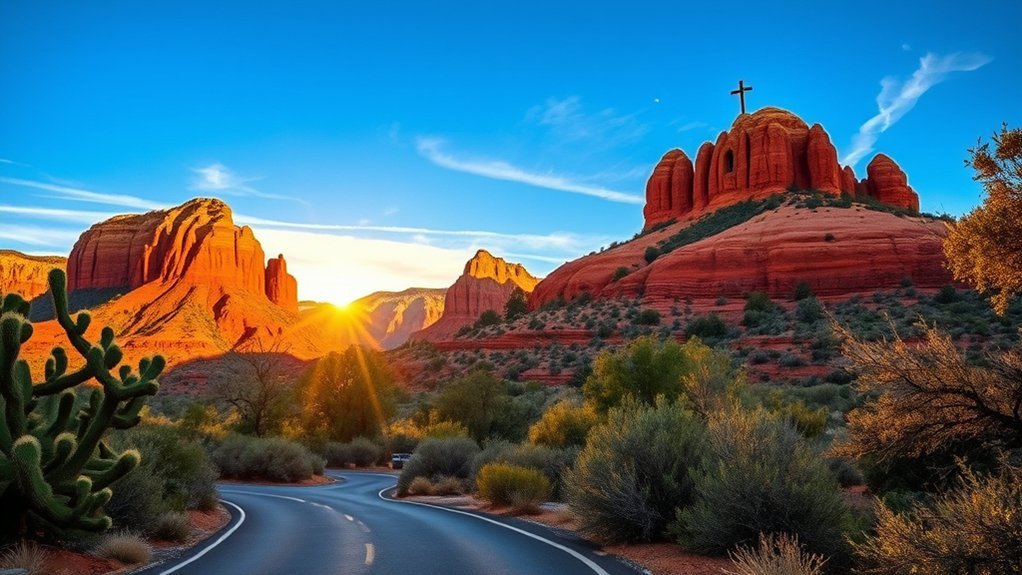
You’ll be struck by the chapel’s dramatic modern lines carved into the red rock and the soaring cross that frames the sky. Walk the short paths to several viewpoints — one gives sweeping views for photos, another offers an intimate angle of the façade against the canyon. Check posted visiting hours and accessibility notes before you go so you can plan the best light and avoid crowds.
Architectural Highlights and Design
Perched dramaticly against a red-rock escarpment, the Chapel of the Holy Cross feels like a deliberate meeting of faith and landscape — its clean lines and soaring cross cut a bold silhouette against the sky. You’ll notice how modernist restraint highlights the surrounding stone: narrow vertical windows, a cantilevered entrance, and intentional use of concrete that echoes the cliffs. The chapel’s scale feels intimate despite its dramatic siting; you’ll sense design choices that guide your attention upward and outward without distraction.
- simple geometric forms that frame the vista
- exposed materials that mirror the desert palette
- thoughtful proportions that invite contemplation
- integration with the rock rather than domination
- light used as a sculptural element through narrow windows
These elements make it quietly unforgettable.
Best Viewpoints and Photos
While the chapel’s clean silhouette commands attention, the best photos come from moments when you frame it against the red-rock backdrop or let the light through its narrow windows become the subject. Walk the short paths to find angles where the cross aligns with spires of sandstone; that juxtaposition makes a bold composition. Shoot during golden hour for warm tones that deepen crevices and lift the chapel’s pale stone. Don’t forget vertical shots that emphasize height and intimate close-ups of textured walls, weathered bronze, and window panes catching sunbeams. Use a wide-angle sparingly to include sky and cliffs, or zoom in to isolate architectural lines. Stay patient — shifting shadows will reward you with quieter, more dramatic frames.
Visiting Hours and Access
Because the chapel sits on a working parish schedule, plan your visit around its posted hours to avoid disappointment and crowds. You’ll find limited parking, a short walk with steps and ramps, and sometimes a line to enter the sanctuary. Aim for early morning or late afternoon light for quieter, more contemplative moments and better photos.
- Check the official website or call ahead for current opening times and service schedules.
- Arrive 30–45 minutes before peak times to secure parking and enjoy the view.
- Dress respectfully; it’s an active place of worship.
- Note seasonal changes and holiday closures that affect access.
- Bring water and wear sturdy shoes for the approach and viewpoints.
Browse Tlaquepaque Arts & Shopping Village
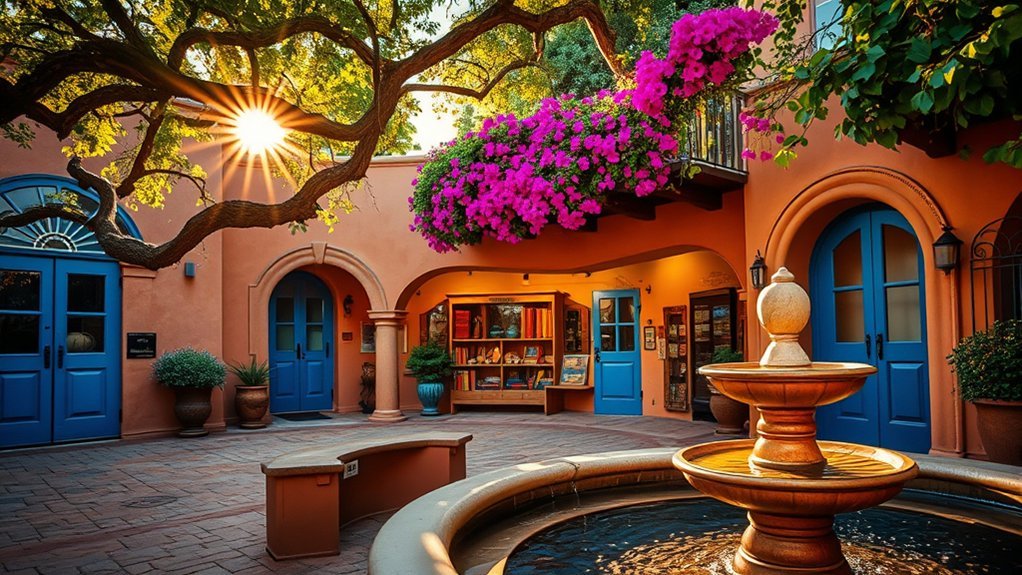
Step into Tlaquepaque Arts & Shopping Village and you’ll feel like you’ve wandered into a sun-drenched Mexican plaza—courtyards ringed with shaded galleries, galleries hung with bright ceramics, and narrow paths that invite lingering. You’ll wander under vine-draped archways, pause at fountains, and catch the scent of roasting coffee from a cozy café. Local artisans display handblown glass, woven textiles, and jewelry that catches the light like fragments of the red rocks outside. You can chat with gallery owners about techniques, watch a potter at the wheel, or pick up a small, meaningful souvenir that’s clearly made by hand. Benches and alcoves invite slow people-watching; every corner frames a postcard-ready view of sandstone ridges. When hunger calls, you’ll find shaded patios serving Southwestern flavors and margaritas. Take your time—this village rewards slow discovery, not impulse rushing—so you leave with something thoughtful and a memory of quiet, art-filled moments tucked into Sedona’s vibrant cultural heart.
Take a Pink Jeep Tour
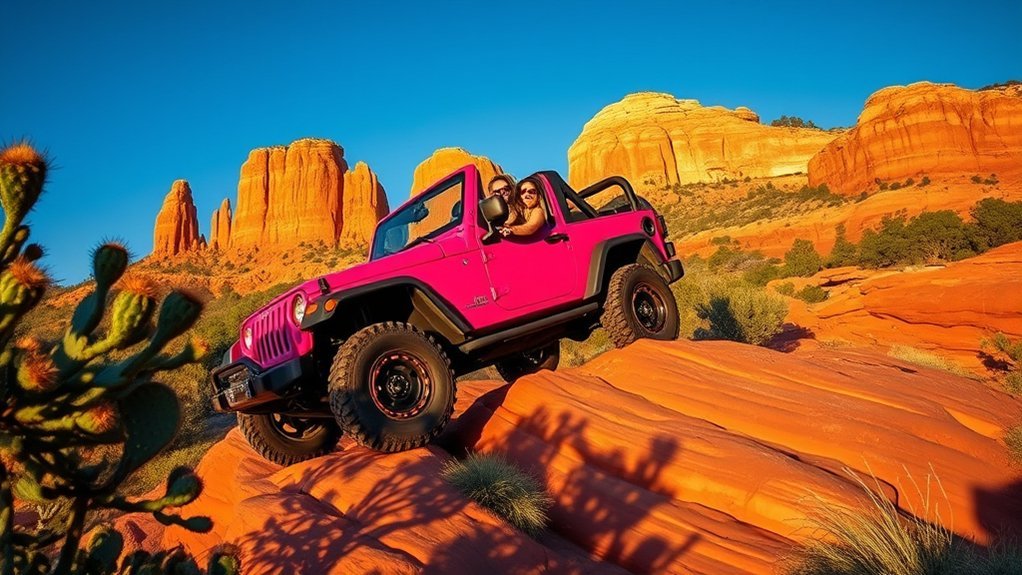
Climb into a pink-jeep and feel the engine rumble as your guide threads the rig up narrow washes and across slickrock, delivering you to viewpoints that are otherwise unreachable. You’ll ride over sun-baked sandstone, glimpse sculpted fins and hidden alcoves, and stop where the wind sharpens the horizon. The guide points out rock names, local plants, and the way light sculpts the canyon walls; you’re close enough to touch the heat-warmed stone.
- Expect occasional jostles that make the whole trip feel alive.
- Bring a hat, water, and a camera with a secure strap.
- Choose a sunrise or late-afternoon slot for richer colors.
- Ask your driver about geology and local lore — they love to share.
- Pack layers; temperatures shift fast between shade and exposed ledges.
The tour balances thrill and calm: every crest reveals a new composition of red, orange, and indigo, and you’ll leave with photos and a clearer sense of Sedona’s wild geometry.
Experience a Sedona Vortex Site
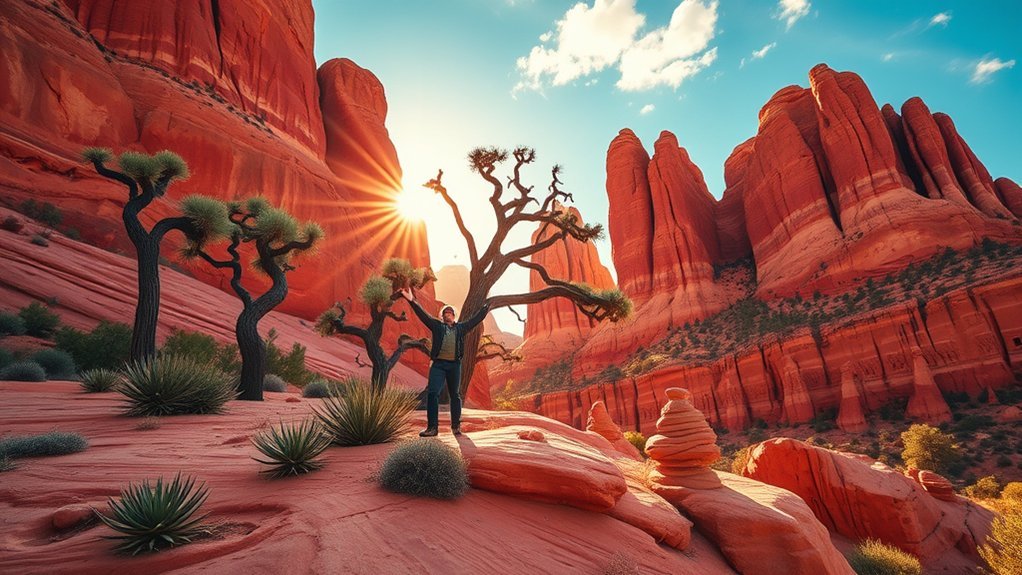
After the thrill of rattling over slickrock, slow your pace and tune into a different kind of energy at one of Sedona’s famed vortex sites. You’ll notice the air seems clearer, the light sharper against red stone. Trails wind to small clearings where pinyon and juniper frame sweeping views; people often sit quietly, palms open, eyes closed, but you can simply stand and breathe. A subtle tension loosens in your shoulders as you walk the concentric paths, pausing to feel the temperature shift or the faint tug some describe as spiritual. Guides will point out spots for grounding, meditation, or simple contemplation, yet you don’t need ceremony—just presence. Bring water, a light layer for sudden gusts, and respect for fellow seekers. Whether you seek introspection, a photo-worthy panorama, or a moment of calm, a vortex visit offers an intimate way to connect with Sedona’s landscape and the stillness that lives within it.
Photograph Broken Arrow Trail
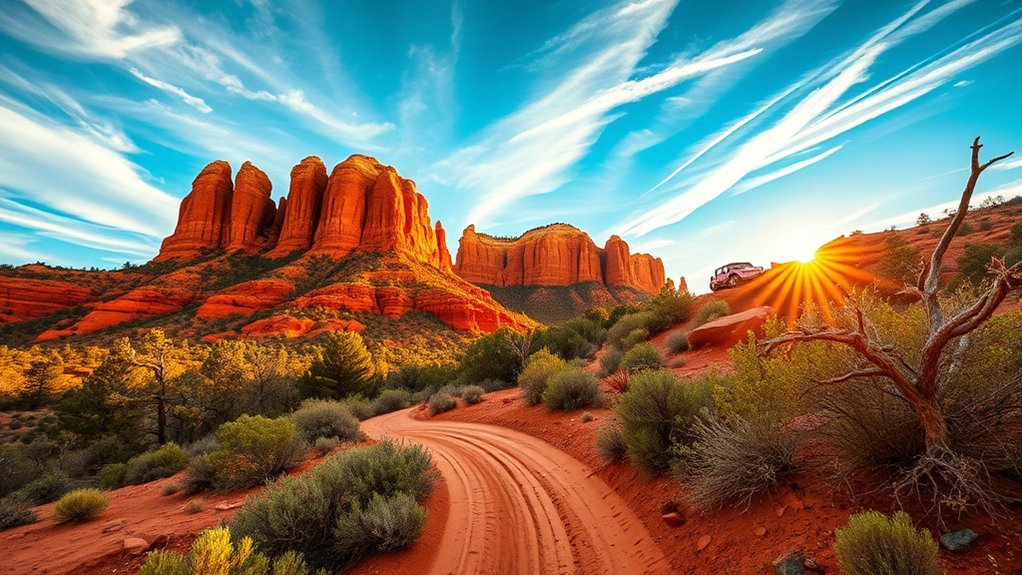
Grab your camera and hike the Broken Arrow Trail to chase iconic red‑rock frames and dramatic light that make Sedona so photogenic. You’ll move through sculpted sandstone fins, pause at viewpoints where shadows carve depth, and find unexpected angles that turn simple rock into cinematic foregrounds. Keep your eyes on texture, warm tones, and the way late-afternoon sun ignites veins of orange and rust.
Hike Broken Arrow with your camera — chase sculpted red‑rock frames, warm light, and cinematic textures at golden hour.
- Shoot during golden hour for soft, directional light and long shadows.
- Use a low angle to emphasize towering formations and layered strata.
- Bring a polarizer to deepen skies and reduce glare on stone.
- Frame cacti or juniper in the foreground for scale and contrast.
- Try bracketed exposures to capture high-contrast scenes and preserve detail.
Walk deliberately, compose with intention, and experiment: panoramic sweeps, tight details, and silhouettes. You’ll leave with images that feel intimate and expansive at once — true Sedona portraits.
Kayak or Paddleboard on Oak Creek
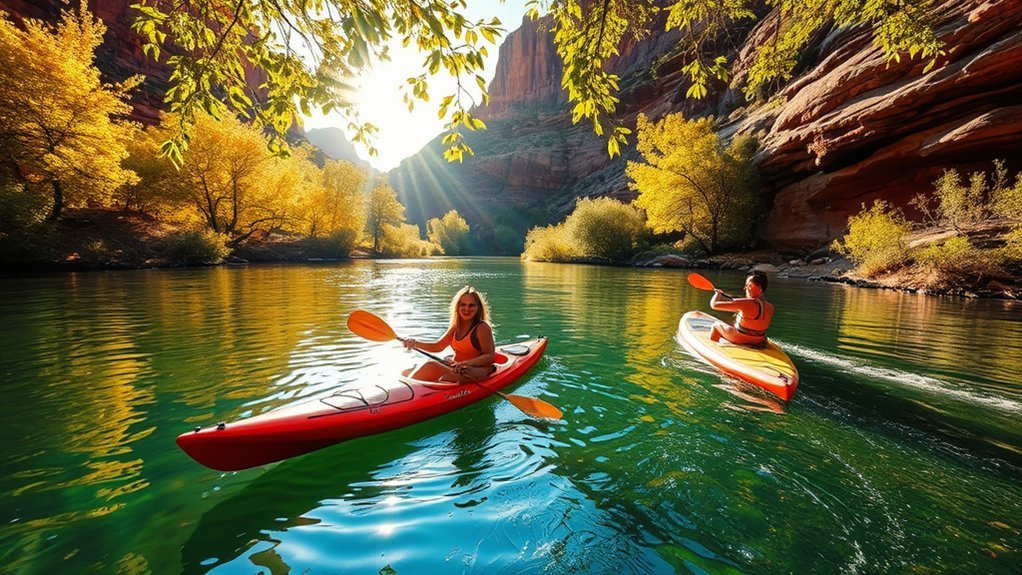
Glide along Oak Creek and you’ll spot the best launch spots tucked under cottonwoods and near mellow riffles where the water’s calmest. You can rent a kayak or paddleboard from nearby outfitters who’ll kit you out with a map and local tips. Stay aware of changing currents, keep right to let faster craft pass, and pack a life jacket — the creek rewards respect.
Best Launch Spots
Along the shaded bends of Oak Creek you’ll find launch spots that suit every skill level—from quiet, shallow runs perfect for a relaxed paddle to slightly swifter stretches where you can test a kayak’s maneuverability; pick your put-in based on how much solitude, scenery, or challenge you want. You’ll want clear water, low brush banks, and easy access points so you can focus on the red-rock reflections and birdcalls. Consider these favorites as you plan your outing:
- Grasshopper Point: calm pools, easy entry, great for beginners.
- Midgley Bridge area: scenic canyon views, moderate current.
- Crescent Moon Picnic Area: family-friendly, sandy shorelines.
- West Sedona trailheads: quieter, more secluded stretches.
- Page Springs: slightly deeper, good for longer paddles and wildlife spotting.
Rental Options Nearby
You’ll find several outfitters within a short drive of Sedona that make it easy to rent a kayak or paddleboard for an hour, a half-day, or a full-day trip on Oak Creek. You’ll pick gear that fits your skill and plans, get clear pickup directions, and be ready to glide under cottonwood shade and red-rock reflections. Rentals often include life vests, dry bags, and simple maps showing scenic stretches and gentle currents. Choose a morning for glassy water or late afternoon for warm light.
| Outfitter | Rental Types | Typical Duration |
|---|---|---|
| Creekside Outfitters | Kayak, SUP | Hour / Half / Full |
| Red Rock Rentals | Tandem Kayak, SUP | Hour / Half / Full |
| Oak Creek Gear | Solo Kayak, SUP | Half / Full |
Safety and Etiquette
After you pick up your kayak or paddleboard and learn the route, keep safety and good manners front of mind on Oak Creek. You’ll glide between red-rock reflections and will want to stay calm, courteous, and prepared so everyone enjoys the water. Follow local rules, watch for changing currents, and respect private shorelines.
- Wear a properly fitted PFD and check gear before launch.
- Keep noise low to preserve wildlife and others’ peaceful float.
- Yield to anglers, give wider berth to slower paddlers.
- Pack out trash, avoid disturbing vegetation or nesting birds.
- Know exit points, tell someone your plan, and monitor weather.
These habits keep the creek pristine and your outing relaxed, safe, and memorable.
Relax at a Sedona Spa
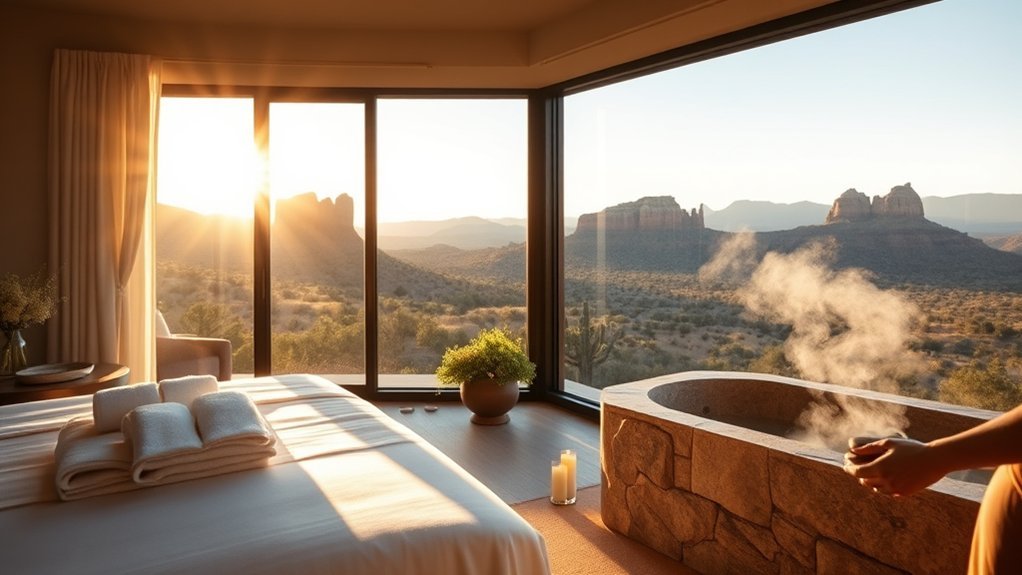
Slip into a quiet treatment room and let the desert slow your breath as expert therapists tailor massages, facials, and body wraps to your needs. You’ll feel the subtle scent of juniper and citrus, hear muted water features, and notice light filtering through red-rock-hued curtains. Choose a deep-tissue massage to unknot travel tension, a hot-stone session to melt soreness, or a chakra-balancing treatment that honors Sedona’s spiritual reputation. After treatment, linger in a relaxation lounge with herbal tea and panoramic views of the buttes; the calm will carry into your evening plans. Many spas use locally sourced ingredients—clay, aloe, sage—that connect each ritual to the landscape. If you prefer movement, book a restorative yoga nidra or a guided meditation on the terrace. Reservations are wise during peak season, and ask about couples’ suites if you’re sharing the experience. You’ll leave feeling grounded, recharged, and more attuned to the region’s slow, radiant pace.
Explore Slide Rock State Park
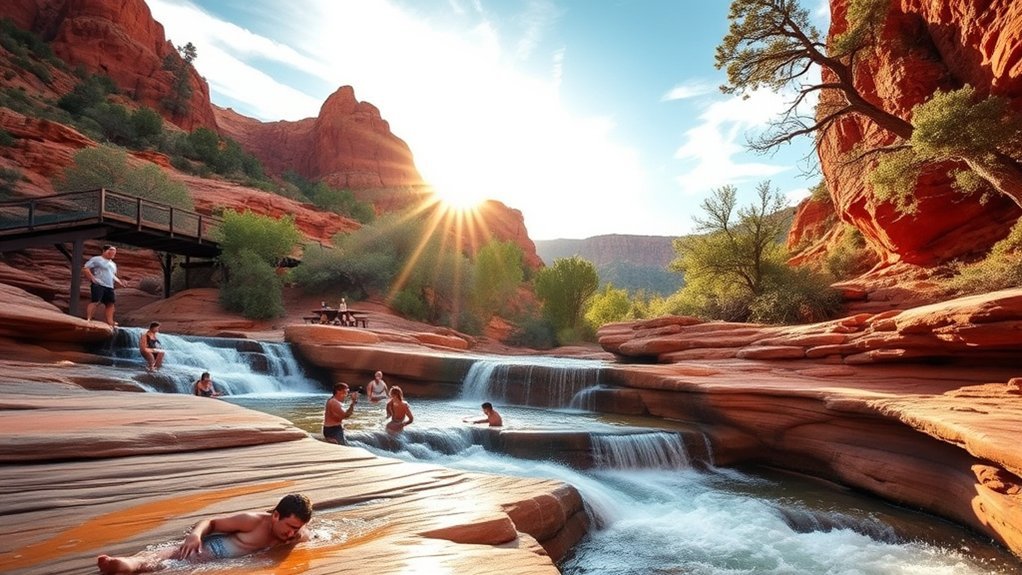
Wade into the clear, cold creek and let the river’s natural water slide carry you downstream through a canyon carved into red sandstone. You’ll feel the smooth rock under your back, hear water riffle through oak and sycamore, and spot sunlit pools that invite a quick plunge. Slide Rock’s mix of gentle adrenaline and serene scenery keeps you present.
- Glide down a natural chute, laughing as spray cools your neck.
- Hike the short rim trail for panoramic views of Oak Creek Canyon.
- Picnic on weather-polished boulders while listening to canyon birds.
- Wade into shallow pools to search for small fish and freshwater critters.
- Time your visit for softer light — morning and late afternoon glow on the cliffs.
Bring reef shoes for traction, a towel, and water; parking fills fast on warm days. You’ll leave with red-orange impressions stuck in memory and a refreshed, slightly sandy grin.
Wine Tasting in Page Springs/Cottonwood
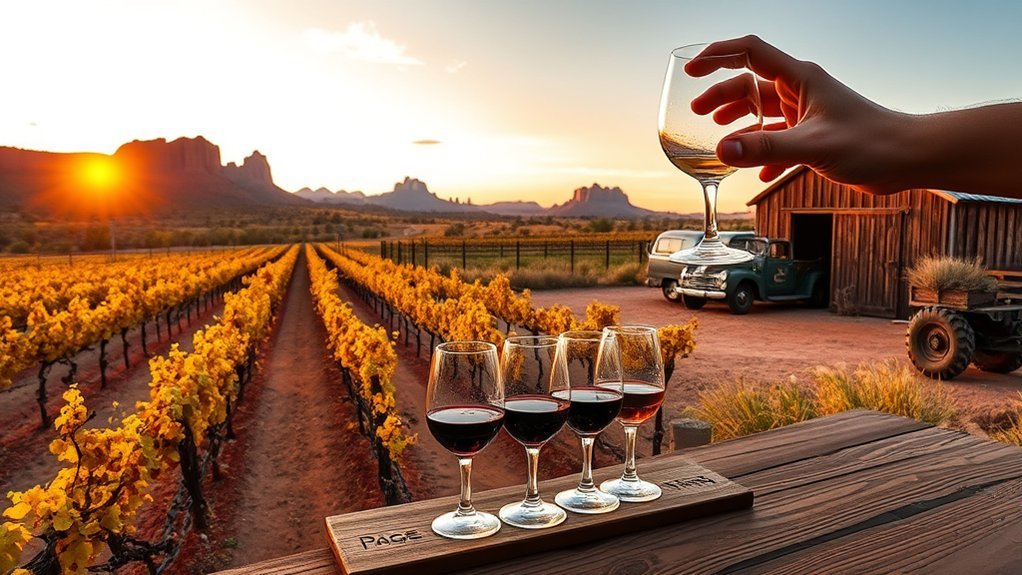
Along the Verde Valley, just a short drive from Sedona, you’ll find Page Springs and Cottonwood’s sun-drenched vineyards where Arizona wines surprise and delight; sip a crisp dry Riesling on a shady patio, compare a bold Syrah at a tasting bar, and watch the light shift across cottonwood-lined creekbeds as vintners talk terroir. You’ll wander small tasting rooms where owners pour with pride, explaining granite soils, irrigation choices, and the valley’s diurnal swings that build acidity and concentrate flavors. Tasting flights let you trace grape character from lean whites to peppery reds while paired small plates sharpen contrasts. Outdoors, pergolas and riverfront benches make lingering effortless; you’ll learn winery histories between sips and catch glimpses of raptors riding thermals above the vines. Whether you favor crisp minerality or velvety tannins, these intimate producers invite curiosity—ask questions, compare notes, and leave with a bottle or two that captures the valley’s surprising, sun-born personality.
Visit the Sedona Heritage Museum
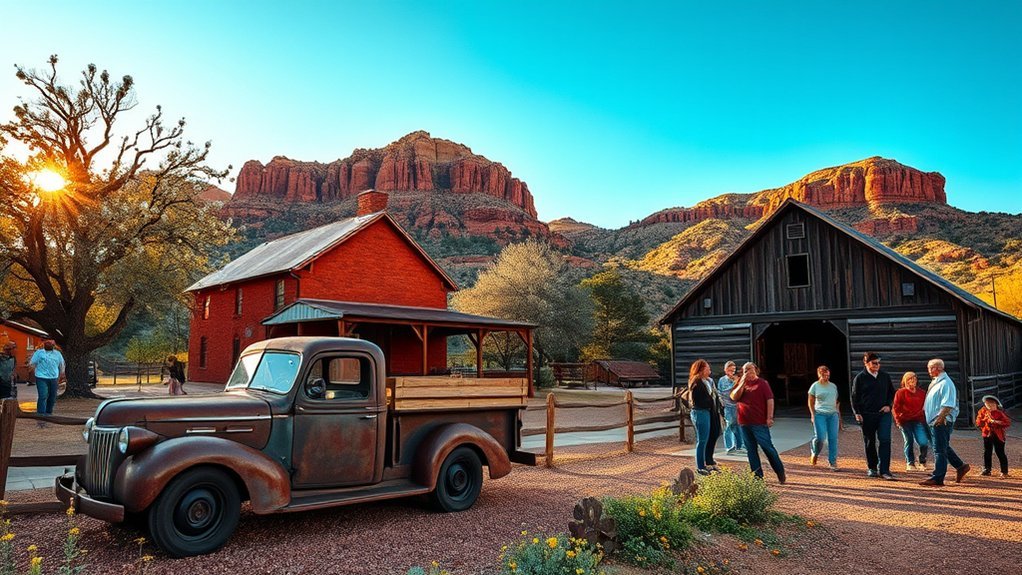
Step into the Sedona Heritage Museum and you’ll find curated exhibits that bring local pioneers, movie history, and ranch life to vivid detail. You can trace the rhythms of historic ranch work through tools, photographs, and restored structures that show how families and cowhands lived and worked. Take your time wandering the grounds to feel the practical, hands-on history that shaped Sedona’s valley.
Museum Exhibits Overview
When you enter the Sedona Heritage Museum, you’ll find exhibits that bring the town’s past to life—from pioneer homesteads and ranching artifacts to vivid displays about Sedona’s film history and Native American presence. You’ll move through intimate rooms and outdoor displays that feel curated just for curious eyes. Pay attention to small details—old signage, period clothing, and photos that place you in different decades.
- Film set photographs and memorabilia that show Sedona’s Hollywood era
- Recreated living spaces that reveal everyday pioneer life
- Native American artifacts and interpretive panels about regional tribes
- Interactive displays that let you trace local stories and maps
- Rotating exhibits highlighting photographers, artists, and conservationists
You’ll leave with a clearer sense of place and history.
Historic Ranch Life
As you wander the Sedona Heritage Museum‘s ranch exhibits, you’ll feel the rhythm of daily life on a working homestead—saddles draped over hitch rails, weathered barn boards still smelling faintly of hay, and a scatter of tools that tell stories of sunrise-to-sunset labor. You’ll trace the worn grooves on milking stools, examine hand-forged nails, and read ledger entries that map seasons of drought and bounty. Interpretive signs and thoughtful displays let you imagine chores done by lantern light, riders heading out at dawn, and children racing across corrals. Docents share personal anecdotes that make names and dates human. By the time you leave, the ranch’s practical beauty and quiet resilience will have settled into your memory like dust on a boot.
Hike Devil’s Dining Room and Fay Canyon
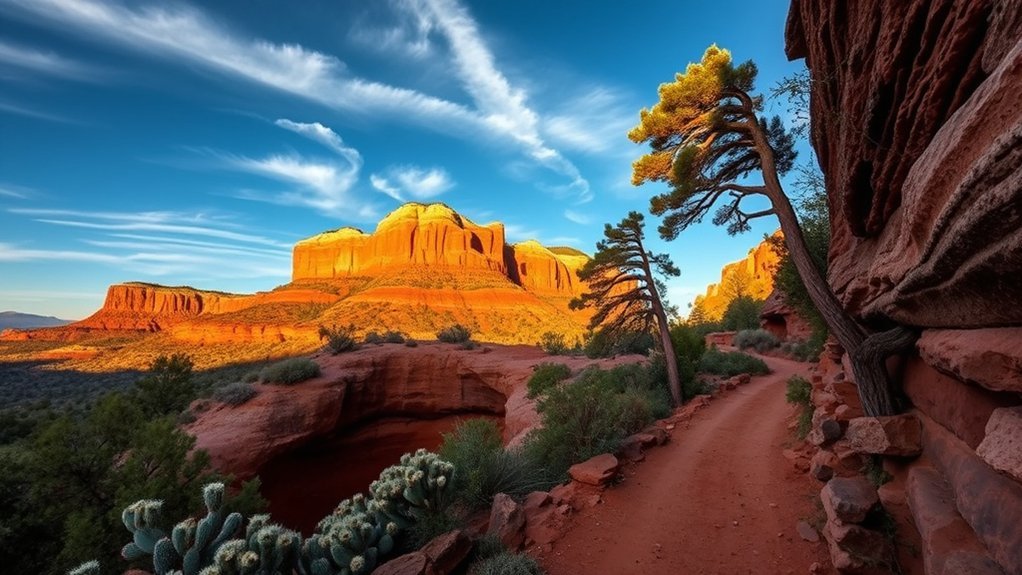
Although both hikes are short, they deliver dramatic red-rock scenery and a sense of discovery that makes you feel a world away from town. You’ll approach Devil’s Dining Room and Fay Canyon expecting easy strolls, but they reward you with sculpted sandstone, unexpected arches, and tight canyon walls that frame bright sky. Devil’s Dining Room offers a shallow cave and shelves of eroded rock where you can pause and imagine ancient storms carving the mesas. Fay Canyon’s wash funnels you beneath colorful cliffs, with occasional side trails that climb to viewpoints. You’ll move slowly, noticing lichen patterns, insect calls, and long shadows that shift the canyon’s mood. Bring water, wear sturdy shoes, and watch for sandstone ledges when the trail narrows. These paths are intimate—perfect for quiet reflection or a lively conversation. Highlights include:
Short, sculpted canyons with arches, alcoves, and shifting light—perfect for quiet reflection or lively exploration.
- Short distances with big visual payoff
- Natural alcoves and small caverns
- Easy navigation for most hikers
- Stunning red-rock photography spots
- Shade pockets on warmer days
Attend a Sound Bath or Meditation Session
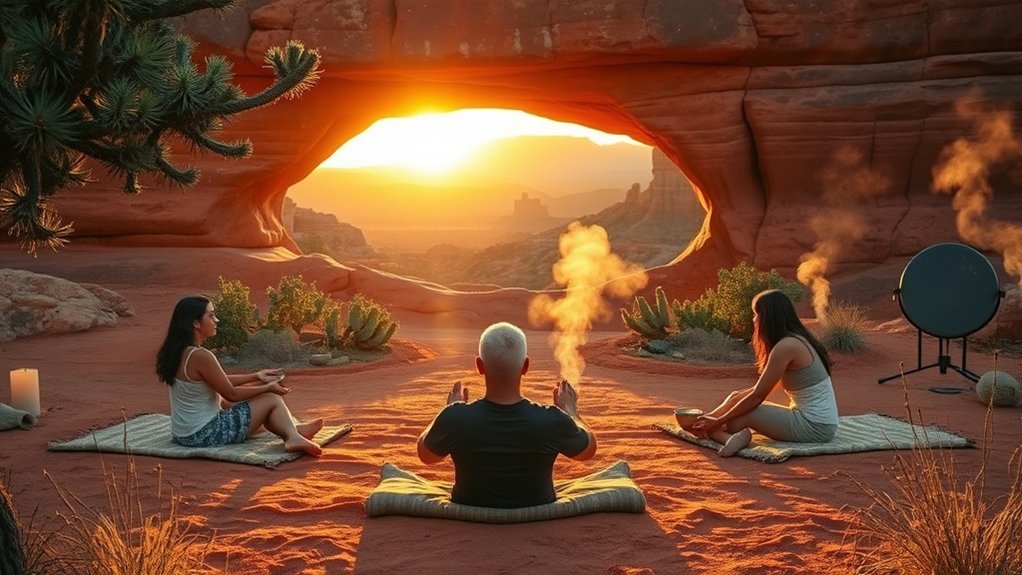
After a day among the red rocks, treat yourself to a guided vortex meditation that helps you tune into Sedona’s unique energy. You’ll lie back as crystal singing bowls wash the room with resonant tones that steady your breath and sharpen your awareness. If you want a more intimate experience, book a private sound bath tailored to your needs and watch tension melt away.
Guided Vortex Meditations
When you step into a Sedona vortex meditation or sound bath, the air seems to slow and the rocks’ hum becomes part of the room; facilitators guide you to breathe with that pulse, sink into the moment, and open to subtle shifts in energy. You’ll be led through gentle cues that focus attention, heighten sensation, and invite personal reflection. Expect quiet guidance, intentional pauses, and invitations to notice sensations without judgment. These sessions often emphasize grounding, visualization, and collective stillness. Bring comfortable layers and an open mind.
- Notice your breath syncing with the landscape
- Feel small muscular releases as tension unwinds
- Observe imagery that surfaces without forcing it
- Share a brief check-in if offered
- Leave slowly, reorienting to daylight
Crystal Singing Bowls
If you enjoyed the guided stillness of a vortex meditation, try settling into a crystal singing bowl sound bath next—its pure, sustaining tones seem to wash over the body and recalibrate attention. You lie or sit as the facilitator circles bowls around you, striking and rubbing rims to release shimmering harmonics. Those tones hang in the air, filling the room with a tactile clarity that nudges breath and loosens tension. You notice subtle shifts: a loosened jaw, slowed thinking, colors behind closed eyes. The experience feels both vast and intimate, like being held in sound. Afterward you move with lighter steps, more present to Sedona’s red-rock light, ready to explore with quieter senses and steadier footing.
Private Sound Baths
Settling into a private sound bath feels like stepping into a personal refuge where each tone is tuned to your pace; here, a facilitator tailors bowls, gongs, or chimes to your needs, guiding you through a focused meditation without the distractions of a group setting. You lie back, breathe, and notice layers of sound unspooling tension: low vibrations under your ribs, bright overtones around your head. The session feels intimate, intentional, and restorative.
- You’ll get one-on-one attention to address stress or sleep issues.
- Sessions often begin with brief intake to set intentions.
- Instruments are placed near key energy centers for targeted resonance.
- Silent pauses let you integrate sensations and insights.
- Afterward, you’ll feel calmer, clearer, and physically lighter.
Mountain Bike the Bell Rock Pathway
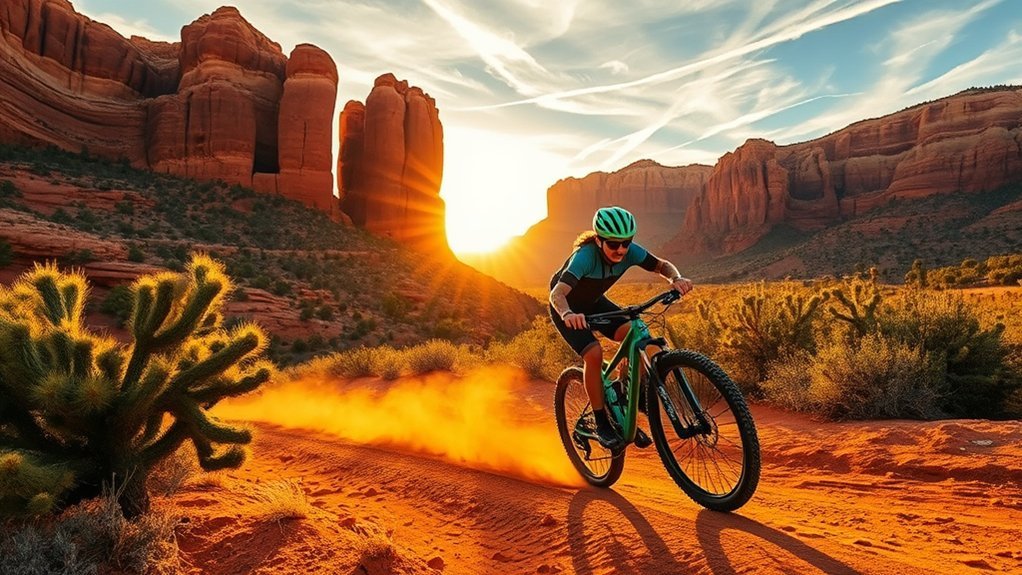
Strap on your helmet and hit the Bell Rock Pathway for a crisp, scenic ride that suits beginners and experienced riders alike. You’ll glide along wide, packed dirt with panoramic views of Bell Rock’s red sandstone silhouette and the surrounding mesas. The trail’s gentle grades let you find a comfortable rhythm; quick rock gardens and short climbs punctuate the ride, keeping it engaging without being punishing. As you pass juniper and prickly pear, the desert scents and warm sunlight make pedaling feel effortless. Stop at lookout points to study layered formations and catch reflections of shifting shadows across the rocks. The pathway connects to loops and spurs if you want to extend your route or test technical skills on nearby singletrack. Bring water, a basic tool kit, and sunscreen—shade’s limited. Early morning and late afternoon offer softer light and cooler air, while mid-day can get hot. Finish with a slow cool-down, savoring how the landscape rewards even a short, spirited spin.
Stargaze at Red Rock State Park
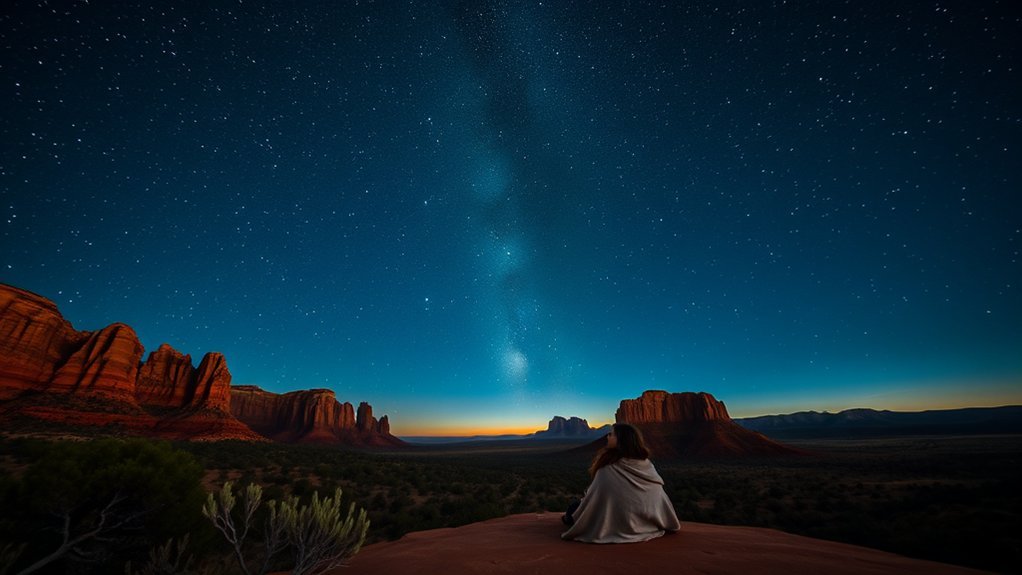
Often the sky here feels unimaginably close, and when night falls at Red Rock State Park you’ll find a vault of stars that outshines city skies. You’ll step onto cool sand, breathe crisp desert air, and watch constellations slide into place above the silhouetted red formations. The Milky Way strips across the horizon; planets gleam like deliberate beacons. You’ll want to lie back, track satellites, and let the silence heighten each tiny, distant light.
- Bring a blanket and layer up—the desert chills quickly after sunset.
- Use a red flashlight to preserve your night vision while moving.
- Download a stargazing app to identify constellations and planets.
- Scout a low, flat overlook for an uninterrupted view of the sky.
- Join a ranger-led program for guided star stories and telescope use.
You’ll leave with a sharper sense of scale and the patient, steady rhythm of desert night sky.
Take a Hot Air Balloon Ride Over the Desert
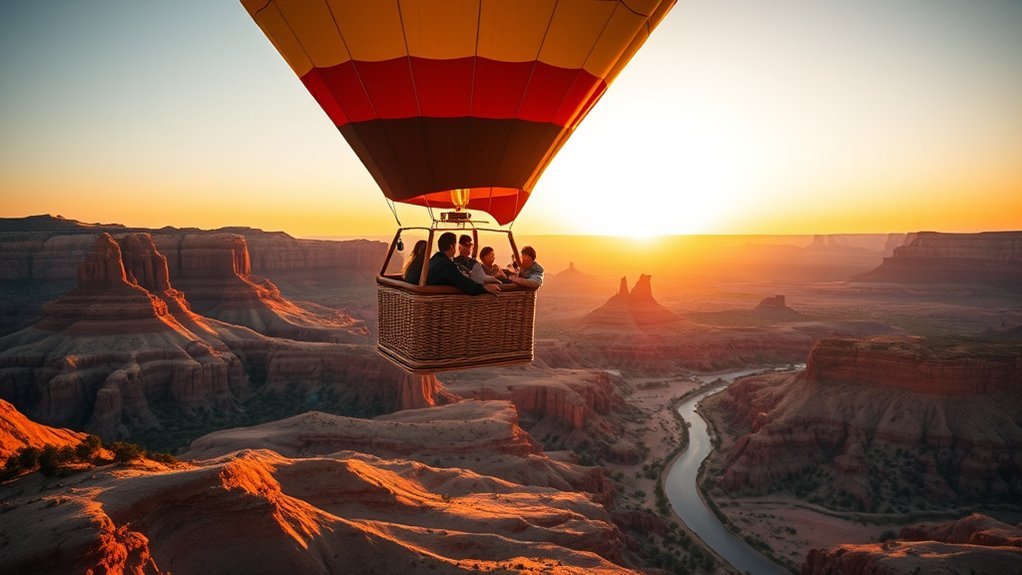
Rising gently at dawn, you’ll float above a patchwork of red canyons, scrub, and orchards as the soft light paints every ridge and spire in gold; the silence is broken only by the occasional hiss of the burner and the faint rustle of your fellow passengers. You’ll watch shadows slide across mesas, notice washes that look like inked veins, and pick out distant trails where hikers like tiny ants trace switchbacks. The pilot points out landmarks—hidden alcoves, a shimmering creek, a cluster of junipers—and explains wind, altitude, and how the balloon responds, so you feel part of the journey rather than just an observer. The air is cool and clean; each panoramic turn reveals new textures and contrasts: deep vermilion rock against pale sky, cultivated green beside wild scrub. Landings are gentle; ground crews greet you with practiced cheer. You step down grounded, lighter somehow, with a fresh perspective on Sedona’s vast, sculpted landscape.
Tour Local Galleries and Crystal Shops
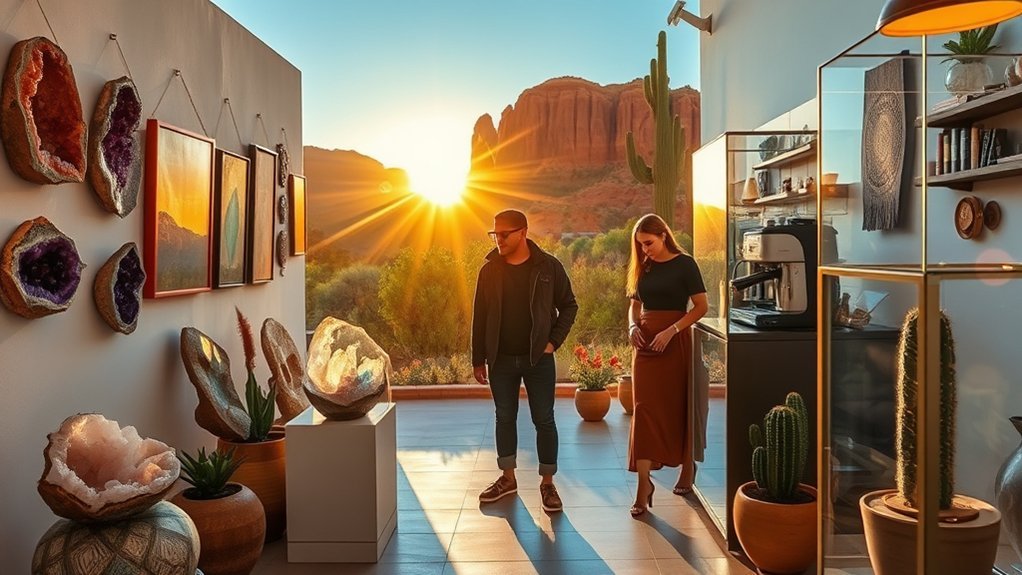
Stroll through Sedona’s compact gallery districts and you’ll find vibrant Native paintings, pottery, and jewelry that reflect the landscape’s colors and stories. Bring a cloth and small scale to inspect crystals closely, ask about sourcing, and compare prices before you buy. Map a hopping route—Tlaquepaque, the Uptown strip, and smaller Oak Creek spots—so you can pop into favorites without backtracking.
Browse Native Art
Wander into Sedona’s galleries and crystal shops and you’ll find a vivid mix of Native American paintings, jewelry, pottery, and carved stone that capture the red-rock landscape and ancestral stories. You’ll notice textured brushstrokes echoing canyon shadows, silverwork set with turquoise like sky pockets, and clay vessels finished with desert-hued slips. Let your eyes trace patterns and ask about makers; many pieces carry family histories and regional techniques. Handle items respectfully, read labels, and chat with gallery staff to learn provenance. Expect to discover artists blending tradition with contemporary voice—each piece invites a connection.
- Hand-tooled silver and turquoise necklaces
- Sand-painted scenes and abstract landscapes
- Pueblo-style pottery and coil work
- Hand-carved kachina and stone sculptures
- Contemporary mixed-media pieces
Crystal Shopping Tips
When you step into Sedona’s crystal shops and galleries, let your eyes move slowly over colors and facets so you don’t miss the subtle differences between specimens—smoky quartz that holds canyon light, amethyst with deep purple zoning, and small tumbled stones polished for pocket talismans. You’ll learn to trust weight, sound, and temperature; hold a piece to feel its pull, tap it gently to hear clarity, and notice how it cools your palm. Ask about origin and treatment, favoring ethically sourced, untreated stones when possible. Compare pieces side by side; a subtle banding or inclusion can change meaning and value. Use this quick reference while you browse:
| Type | Feel | Tip |
|---|---|---|
| Quartz | Cool, dense | Check clarity |
| Amethyst | Slightly warm | Look for zoning |
| Tumbled | Smooth | Inspect polish |
Gallery Hopping Routes
After you’ve learned to read stones by feel and sight, map a route that threads Sedona’s galleries and crystal shops into a single, rewarding outing. Start in Tlaquepaque to soak up adobe courtyards and first-look displays, then drift toward Uptown for eclectic finds and people-watching. Let light guide you—midday sun brings out color in minerals; evening lamps reveal texture. Pause to ask artists about origins, and carry a small notebook for shop names and favorite pieces. Plan for flexible pacing so you can linger where a stone or painting speaks to you.
- Begin at Tlaquepaque for atmosphere and high-quality galleries
- Pop into Uptown for tourist-friendly variety
- Visit Chapel-area shops for spiritual-focused crystals
- Stop at newer, smaller studios off main roads
- Finish with a sunset-view gallery to reflect purchases
Hike Soldier Pass and Visit the Seven Pools
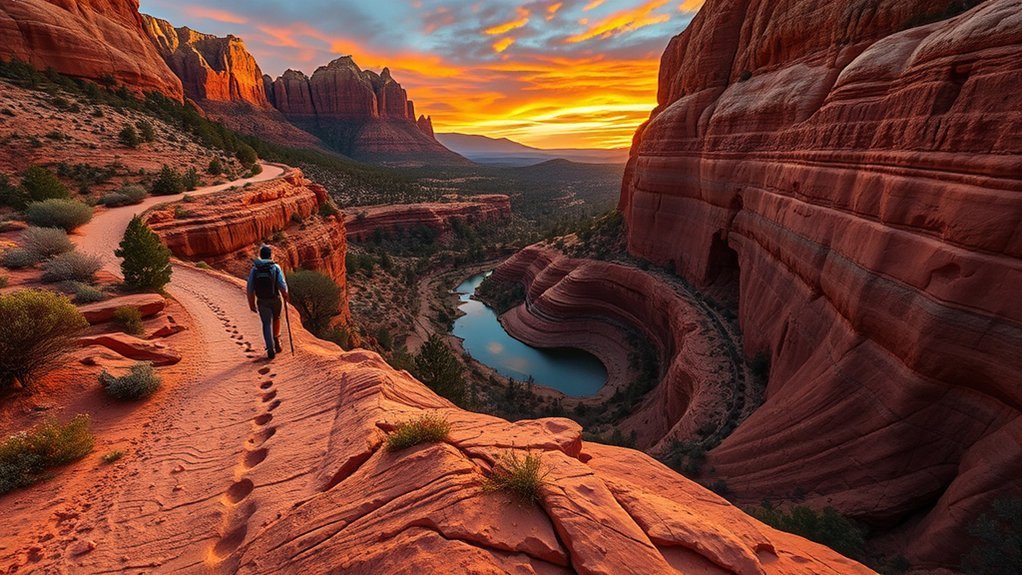
Take the Soldier Pass trail and you’ll step into one of Sedona’s most rewarding short hikes, where red-rock cliffs, shady juniper, and geological wonders unfold with every switchback. You’ll move past carved sandstone walls and cross sun-dappled washes, noticing fossil-like striations and delicate lichen patterns on the rocks. Keep an eye for the Cave Spring and the Devil’s Kitchen sinkhole — dramatic reminders of the landscape’s slow work. The trail narrows, opens, then leads you to the Seven Pools, a series of natural basins that collect rain and runoff; after rains they glint like a string of tiny mirrors. You can peer into the clear basins, hear water trickle, and watch dragonflies skim the surface. Shoes with good tread help; some sections are slick when wet. Bring water, a hat, and a camera for framed views through red fins. The hike rewards you with close-up geology and quiet moments beside cool, curving pools.
Dine With a View at a Cliffside Restaurant
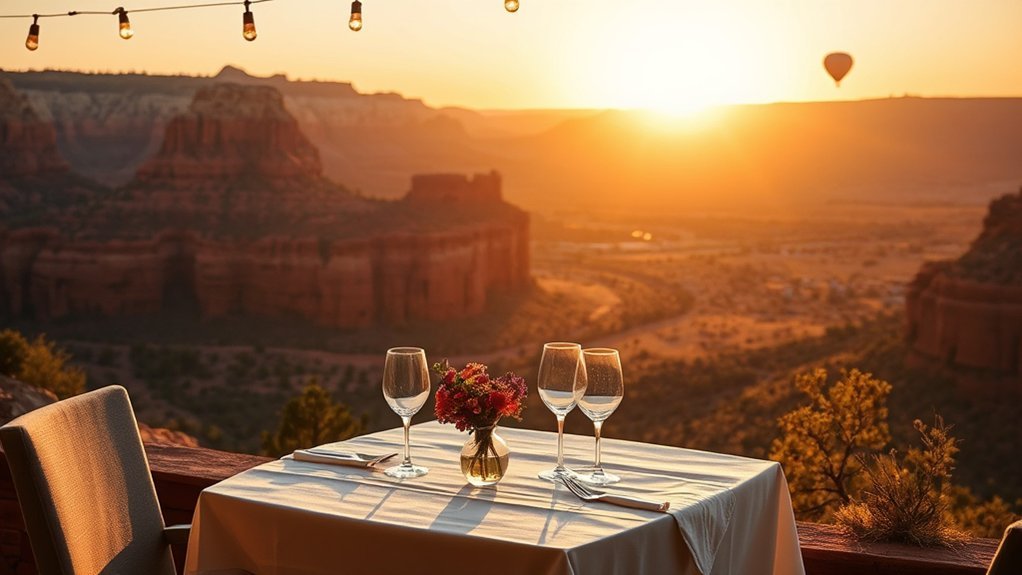
Perched on a red-rock edge, a cliffside restaurant lets you eat with the canyon spread out beneath your plate, the glassed verandas framing buttes and distant sunset bands. You’ll notice how light sculpts the mesas while servers move quietly, and how your meal tastes sharper with that panorama. Choose a table near the rail, order something seasonal, and watch colors shift from ochre to wine.
- Savor dishes that echo local flavors—roasted vegetables, grilled fish, citrus accents.
- Time your reservation for golden hour to catch the sky deepening and lights waking.
- Dress in layers; evenings on the rim get cool even after hot days.
- Bring a camera but also pause to drink the view without lenses between sips.
- Ask for cocktail or wine pairings that complement the spice and smoke on the plate.
Dining here turns a meal into a moment: intimate, cinematic, and utterly anchored to Sedona’s skyline.
Join a Guided Geology or Nature Walk
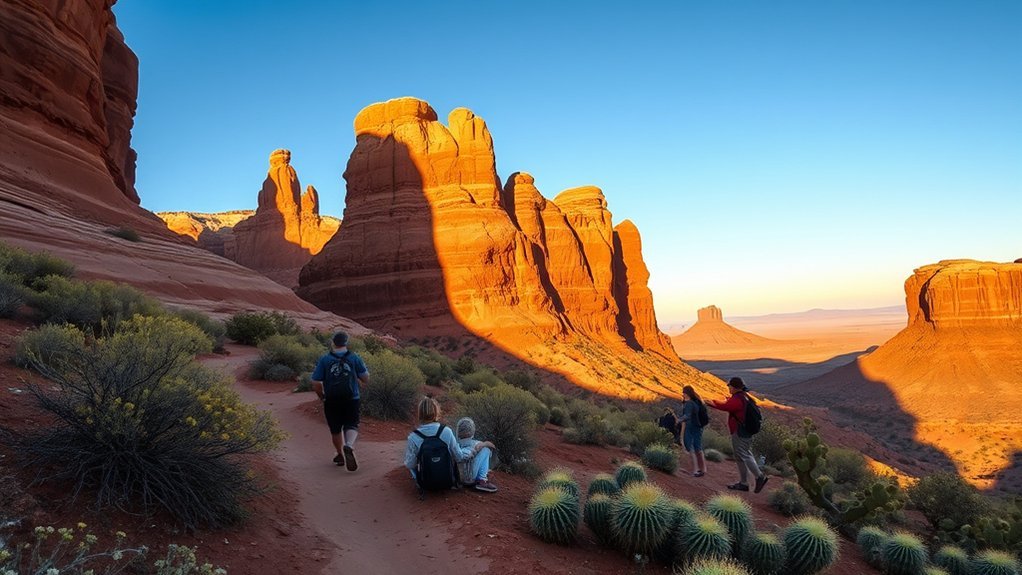
When you join a guided geology or nature walk, a local guide turns the red rocks and scrub into a living classroom, pointing out how layers of time, water, and wind shaped the canyons and why certain plants cling to shaded crevices. You’ll hike at a careful pace, eyes tracing striations, fossil hints, and subtle shifts in mineral color that tell ancient stories. Guides name formations, explain erosion patterns, and show you how to read a landscape like a map. You’ll learn to spot desert wildflowers, juniper scars, and lichens that signal microclimates, and you’ll hear about animal habits and seasonal rhythms that keep this place resilient. The talks blend science with local lore, so you leave with both facts and a sense of place. Whether you’re after photography tips, family-friendly exploration, or quiet reflection, a guided walk sharpens observation and turns scenery into deeper connection.
Frequently Asked Questions
When Is the Rainy/Monsoon Season in Sedona?
The monsoon rainy season in Sedona runs roughly from mid-July through September. You’ll see sudden afternoon storms, dramatic lightning, and brief intense downpours, so you’ll plan hikes early, carry rain gear, and watch swollen washes carefully.
Are Dogs Allowed on Most Sedona Trails?
Yes — you can bring dogs on many Sedona trails, but leash rules and restrictions vary; you’ll need to keep your dog leashed, follow posted rules, pack out waste, and avoid sensitive or restricted wilderness areas for safety.
What Permits Are Needed for Commercial Photography?
You need a permit for commercial photography on most public lands; private land owners also require permission. You’ll request permits from federal, state, or local agencies, pay fees, and follow restrictions to protect fragile landscapes and access.
Where Are the Nearest Hospitals or Urgent Care Centers?
The nearest options are Verde Valley Medical Center in Cottonwood (about 20–25 minutes), Sedona Hospital in West Sedona (10–15 minutes), and several urgent cares in Sedona and Cottonwood; call ahead or check hours before you go.
Is Cell Service Reliable Across Red Rock Areas?
Imagine signal bars like scattered lighthouses on red cliffs; no, cell service isn’t uniformly reliable. You’ll find strong coverage in town and main trails, but remote canyons and ridgelines often drop calls, so plan accordingly.
Conclusion
You’ve just scratched the surface of Sedona’s red-rock magic, but what you’ve seen proves it’s worth its weight in gold: hike, paddle, shop, pause and let the views do the talking. Whether you chase sunsets on Airport Mesa, search vortex sites for quiet, or savor a cliffside meal, you’ll find moments that stick with you. Go with curiosity, slow down, and let Sedona work its restorative charm—you’ll leave lighter and more rooted than when you arrived.

